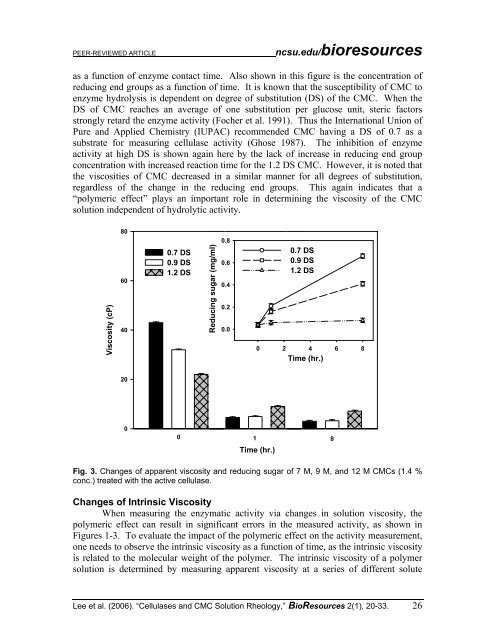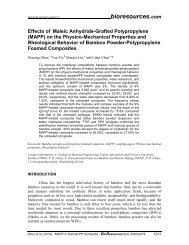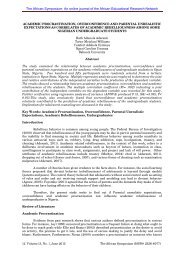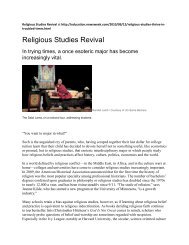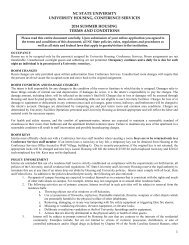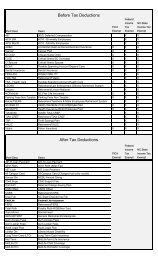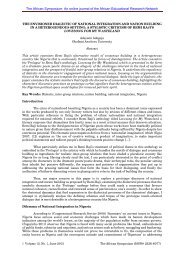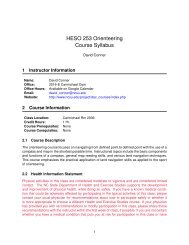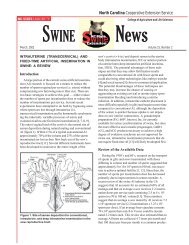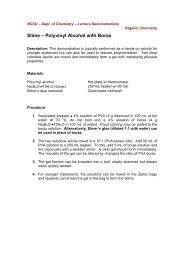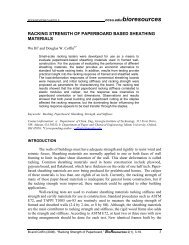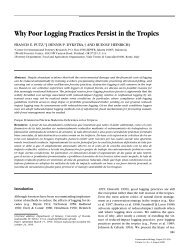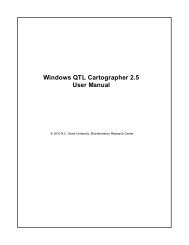Rheology of carboxymethyl cellulose solutions - North Carolina ...
Rheology of carboxymethyl cellulose solutions - North Carolina ...
Rheology of carboxymethyl cellulose solutions - North Carolina ...
Create successful ePaper yourself
Turn your PDF publications into a flip-book with our unique Google optimized e-Paper software.
PEER-REVIEWED ARTICLE ncsu.edu/bioresources<br />
as a function <strong>of</strong> enzyme contact time. Also shown in this figure is the concentration <strong>of</strong><br />
reducing end groups as a function <strong>of</strong> time. It is known that the susceptibility <strong>of</strong> CMC to<br />
enzyme hydrolysis is dependent on degree <strong>of</strong> substitution (DS) <strong>of</strong> the CMC. When the<br />
DS <strong>of</strong> CMC reaches an average <strong>of</strong> one substitution per glucose unit, steric factors<br />
strongly retard the enzyme activity (Focher et al. 1991). Thus the International Union <strong>of</strong><br />
Pure and Applied Chemistry (IUPAC) recommended CMC having a DS <strong>of</strong> 0.7 as a<br />
substrate for measuring cellulase activity (Ghose 1987). The inhibition <strong>of</strong> enzyme<br />
activity at high DS is shown again here by the lack <strong>of</strong> increase in reducing end group<br />
concentration with increased reaction time for the 1.2 DS CMC. However, it is noted that<br />
the viscosities <strong>of</strong> CMC decreased in a similar manner for all degrees <strong>of</strong> substitution,<br />
regardless <strong>of</strong> the change in the reducing end groups. This again indicates that a<br />
“polymeric effect” plays an important role in determining the viscosity <strong>of</strong> the CMC<br />
solution independent <strong>of</strong> hydrolytic activity.<br />
Viscosity (cP)<br />
80<br />
60<br />
40<br />
20<br />
0<br />
0.7 DS<br />
0.9 DS<br />
1.2 DS<br />
0<br />
Reducing sugar (mg/ml)<br />
0.8<br />
0.6<br />
0.4<br />
0.2<br />
0.0<br />
0 2 4<br />
Time (hr.)<br />
6 8<br />
Lee et al. (2006). “Cellulases and CMC Solution <strong>Rheology</strong>,” BioResources 2(1), 20-33. 26<br />
1<br />
Time (hr.)<br />
0.7 DS<br />
0.9 DS<br />
1.2 DS<br />
Fig. 3. Changes <strong>of</strong> apparent viscosity and reducing sugar <strong>of</strong> 7 M, 9 M, and 12 M CMCs (1.4 %<br />
conc.) treated with the active cellulase.<br />
Changes <strong>of</strong> Intrinsic Viscosity<br />
When measuring the enzymatic activity via changes in solution viscosity, the<br />
polymeric effect can result in significant errors in the measured activity, as shown in<br />
Figures 1-3. To evaluate the impact <strong>of</strong> the polymeric effect on the activity measurement,<br />
one needs to observe the intrinsic viscosity as a function <strong>of</strong> time, as the intrinsic viscosity<br />
is related to the molecular weight <strong>of</strong> the polymer. The intrinsic viscosity <strong>of</strong> a polymer<br />
solution is determined by measuring apparent viscosity at a series <strong>of</strong> different solute<br />
8


